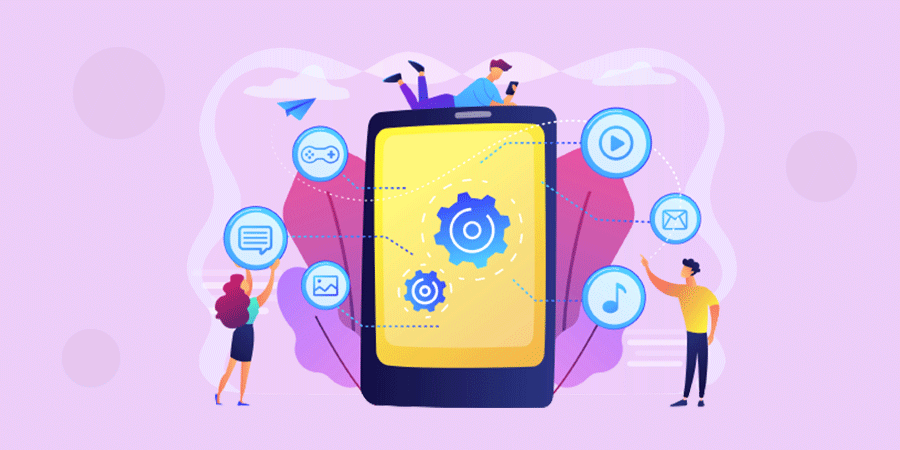Technology-focused and geeky fields aren’t the only ones that can benefit from apps. It is now more important than ever to have a mobile app for your company, regardless of how prominent your company is online. You can improve your company’s operations, marketing techniques, client retention, and more by creating an app that allows customers to contact you or make purchases on the move.
The creation of a mobile app is no longer a difficult task. The number of people using mobile devices is expected to surpass 5 billion by the beginning of 2022. The annual growth rate of app users is between 7% and 8%. On the other hand, developing a top-notch mobile app requires extensive preparation.
As mobile apps continue to proliferate, this becomes even more significant. Most people who own smartphones use them primarily to access various applications. You need an app if you want your business to succeed. Still, if you don’t know what you’re doing, it’ll be difficult to create a top-notch app. Let’s analyze the app creation process so you know what to anticipate, how much money you’ll need, and how to go about producing a great app for your company without making any blunders.
Business Considerations Before App Development
Before we get into the process of developing mobile apps, let’s have a look at some of the most important considerations that businesses need to make before beginning the app creation process.
1. Researching the Market
Market research is a recommended practice before releasing a new app. It will help you zero in on the specifics of what you need. Think about the advantages and disadvantages of your opponents’ strategies. If you want to zero in on your ideal clientele, it’s a good idea to analyze the feedback you’ve received from existing ones. If you do your market research well, you can perhaps avoid making the same mistakes.
2. Choosing a Sturdy Design
When making a mobile app, it’s important to use the right system. You should prioritize the app’s user interface while choosing between the Android and iOS frameworks. Applications’ adaptability will be impacted. It’s important to choose the technology that lets you make the most of your efforts while still providing the most security and discretion.
3. Identify Your Consumer Base
Your audience is in charge. You’ve defeated the purpose of having a fantastic program if no one wants to use it. As a result, you must identify your ideal customers. You’ll lose track of what you’re doing if you don’t know your customer, then your app will fail. Understanding your intended audience’s expectations and requirements is crucial for your application’s success. If you cannot persuade your clients’ expectations, you will not contact them again. It is critical to understand your client’s needs and to align your mobile application goals with their understanding.
4. Focus on App marketing
We live in a time when information is at our fingertips, therefore it’s crucial to stay in touch with our customers as quickly as possible. The more people hear about your launch, the more curious they will be. Ensure that your strategy is solid and well-considered. If you want to get your name out there, you may engage a digital marketing company to do the job for you.
5. UI/UX
How do people feel when they use your app and do they find it interesting? The success of your app depends on these two factors. There will be problems with your mobile app if the user interface and user experience do not interest your target audience. So, enhancing the user experience (UX) is one of the best practices to attract customers. Your content will fail no matter how alluring it is if the user interface (UI) and user experience (UX) don’t persuade people to use it. This is why top-tier mobile app developers place so much emphasis on crafting a seamless user experience.
6. User’s Confidentiality
Make sure you have a reliable security mechanism in place before collecting any personal information from your users. Security is of the utmost importance if your mobile app has anything to do with fintech or other financial mobile applications. However, you must create a privacy policy that describes the data you intend to collect and how you plan to use it. Security is an essential part of app creation that needs to be considered from the get-go. The data you collect from your website’s visitors is invaluable. If you can assure them that it will not be misused and that a solid and effective system will be set up to store and protect it, that would be great.
Lifecycle & Developmental Phases of the App
There must be a continuous cycle of ideation, prototyping, coding, and releasing when developing an app. However, the entire procedure of creating an app may be broken down into a few distinct phases, beginning with the creation of a concept or prototype and ending with the app’s release on all compatible devices. Let’s try to figure out what each tier is.
1. Phases of Research & Planning
The first thing you should do is conduct extensive market and rival app research. It’s important to plan out the specifics of your app’s creation and promotion in advance, so it’s a good idea to think about things like the app’s intended audience, preferred platforms, app development language and frameworks, features offered by similar apps, and whether or not you want the same or different features, as well as a timeline for development, launch, and promotion. A proper return on investment (ROI) can be determined by early-stage strategic business research, which in turn can aid with budgeting and planning.
2. Wireframes
The following phase involves writing up documentation and creating a wireframe for your app. Making comprehensive sketches of your ideas for the app’s design phase, functionality, and other aspects is a huge assistance when it comes time to actually develop it. After completing the rough sketches, you can go on to wireframes for further development. You can now properly arrange your design’s components and see obvious usability problems. In this stage, you’ll envision how your finished app will look after you’ve implemented all of your features and ideas. Without saying, this is where your imagination may really run wild.
3. Back-End Evaluation & Technical Feasibility
After you’ve nailed down the graphics for your app, you’ll want to make sure the back end can handle its newfound power. Consider application programming interfaces, data models, data integration, servers, push alerts, etc. Whether you’re creating an app for Android or iOS, you’ll need to meet a few specific conditions. In addition, the various platform formats (mobile, wearable, tablet, etc.) will call for significantly different back-end functionality. If you find that part of the original functionality isn’t viable by the conclusion of this step, you can skip it. Consequently, you’ll be able to reevaluate and reconsider those aspects.
4. Prototyping
You should get started right away on putting together a quick prototype now. It is impossible to get a feel for the user experience of the application development unless the software is really used and the functionality of the app is seen. Build a prototype, then give it to a user so they can give you input on how the final product will look, how it will feel, and how it will operate. Pay attention to constructive criticism because it can help you chart a road for further development.
5. Design
After completing the prototype, you can next go on to the coding phase. It is time for your UI and UX designers to grab the reins. User experience (UX) designers are concerned with how the various facets of the design stage interact with one another, whereas user interface (UI) designers are responsible for giving your application its appearance and personality. You will find visual instructions in this section. These act as a road map for expressing to the technical team the user experience and product direction that you want to see implemented.
6. Develop
This stage can be observed to begin very fast from a certain perspective. During the process of the project lifecycle, it is necessary to both create a prototype that is functional and assess the development of the prototype at regular intervals. The essential capabilities, on the other hand, are being put through their paces as this phase proceeds. When everything has been checked over and the app is ready, it is submitted to production.
Each and every one of the issues has been resolved. When working on a challenging project, it is often necessary to break a large program down into smaller modules so that it can be finished and made ready for release. This is done since it is more manageable this way.
7. Testing
Testing is a crucial part of the mobile app development process. In order to keep the total expenditures down, it is recommended to begin testing as soon as possible. It becomes more expensive to address technical flaws and faults the further along in the development life cycle they are. All aspects of the program, including usability, compatibility, interface, security, stress, and performance, should be tested at this point. You should have some of your intended users try it out for you.
You’ll find out how people generally feel about your app and whether or not they have any problems with it. It is the process of evaluating an app based on how well it performs its intended tasks, how intuitively it is laid out, how well it interacts with its users, and how pleasant the user experience is. The process entails
- UAT, or “User Acceptance Testing,”
- Initial Release
In this scenario, a select group of users is given the app to evaluate. Through this kind of testing, consumers learn about things like typos, design problems, usability issues, security vulnerabilities, alterations to the layout, and so on. In order to gauge customer satisfaction with their app, developers can conduct surveys and polls.
The feedback from actual users is crucial in this case because the app is available to everyone. As part of this phase of testing, the developers make a preliminary version of the app available to participants. Users give detailed feedback to programmers. And you can use this information to refine the program in light of comments made by beta users.
8. Deployment
By now, your application should be complete. Pick a date for the big unveiling. Android app development and iOS app development have different release policies. Don’t let those variables get out of hand. Remember that you still have a ways to go in this process. This is a fresh start in and of itself. As soon as the app is released, users will begin providing input, which will need to be included in subsequent updates. This marks the beginning of the next phase of development. Throughout this process, be sure to keep tabs on your available resources and long-term dedication to the project.
9. Publishing
The process of developing your app is not complete until you publish it, and this marks the pinnacle of that process. This is the second-to-last step in the process of developing an app. You need to make an announcement regarding the launch date through various media campaigns. It will be necessary for you to hire marketing teams, plan out social media campaigns, advertise through word of mouth, or send emails to various people or organizations that have shown an active interest in your app.
10. Maintenance & Updates
However, keeping the app running smoothly and regularly updating it are the final goals of app development. You add complex features from the project’s backlog to the app and give it a final polish. Any respectable developer will offer technical support for any other problems that may emerge. Here you need to take the initiative and coordinate user participation with frequent app upgrades. Implementing user suggestions is essential. There are a lot of moving parts that you need to maintain in the app, such as new features, bug repairs, and design changes. That makes app creation an ongoing cycle. After this last stage is complete, the app development process may begin in earnest.
Build a Robust Mobile App With Experts
The complexity of the mobile app development lifecycle should be clear by now. It’s vital to remember that the app market is a very competitive environment in addition to the execution of these hard stages. In light of the possible market loss that could result from even a minor misstep, businesses developing new applications need to exercise considerable caution throughout the app development process. That’s why most businesses choose to employ mobile app developers: so they can get a custom app made. To that end, you may rely on the expertise of our developers, who are equally adept at creating apps for the iOS and Android platforms.





